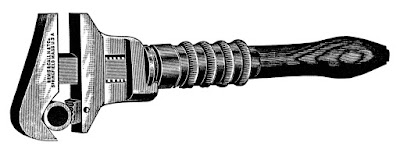There's a type of idiom that is international in scope.
One brick short of a load.
A few clowns short of a circus.
One taco short of a combination plate.
A few beers short of a six-pack.
Three bangers short of a barbie.
A few cards short of a deck.
A few tiles short of a roof.
All foam, no beer.
The universal message here is that there is something short of what's needed: skill, brains, tools, or what has been ordered.
I bring this up because as I listen to people talk about dog training, I so often feel as if they have shown up with half the tools, and a quarter of the knowledge, needed.
Terms are poorly defined, limited experience is generalized, and techniques for one thing are assumed to work on all things, and all dogs, all the time.
Some time back, I wrote a post about "cutting sign" in the world of dogs.
Cutting sign. That's what they call it along the U.S.-Mexico border. You might know it as tracking, but of course, it's more than reading tracks on a dusty road, isn't it?
Along the border, they are not just looking for tracks in the dirt -- they are also looking for haircuts from other countries, bell bottoms that have been out of style in the U.S. for decades, and dress shoes worn in the desert or on slaughter house work floors.
If a Border Patrol officer asks a simple question, the answer may reveal whether the person answering comes from Texas, Mexico, El Salvador, or parts father South, East, West or North.
Of course, you can cut sign anywhere; all it takes is an ability to notice details and ask what they mean. You will never be Sherlock Holmes (who is?) but you might get good at gleaning a larger meaning from the presence, or absence, of small things.
So what small things -- or large things -- can tell you quite a lot in the world of dog training?
Lack of knowledge about basic dog training tools.
If you are putting yourself out there as a dog trainer, you should know how to use the full panoply of equipment commonly used in the world of dog training.
Dog trainers should have more than a few flat collars and leashes.
If you do not own a treat bag and have never used food rewards, you are not only incompetent to talk about the value of food rewards, you are incompetent to take someone's money as a full service dog trainer.
If you do not own a clicker or two and know how they are used as markers, you are not only incompetent to talk about them, you are incompetent to take someone's money as a full service dog trainer.
If you do not own a pinch collar and know how to fit one and have never used one, you are not only incompetent to talk about them, you are incompetent to take someone's money as a full service dog trainer.
If you do not own a slip collar and know how to fit one and have never used one, you are not only incompetent to talk about them, you are incompetent to take someone's money as a full service dog trainer.
If you do not own a modern e-collar and taken the time to learn to see what low-level stim can do, you are not only incompetent to talk about them, you are incompetent to take someone's money as a full service dog trainer.
Yes, 85 percent of all plumbing work is knowing how to snake a sink or toilet and how to replace small pipe connections.
That said, if you show up on a construction site claiming to be a plumber, your tool set better be more robust than a power snake and a butane torch!
And so it is in the world of dogs. Just as you can judge a plumber or carpenter by his tools, so too can you judge a dog trainer.
You don't have to use any tool or every tool. But with so few tools in the box when it comes to dog training, you should know how to use all the basic tools of the trade.


1 comment:
I also like 'all hat and no cattle' or 'all sizzle and no steak'.
I think my most valuable training tool is my voice. If I lost it today, I'd stop training or take a very long time to regroup. Oh I can use a clicker and every collar/ leash combo out there, and I always pair a hand signal with a vocal command. I've even trained deaf dogs so that I could learn new skills. But I started training as a young teen with packs of dogs (with no formal training myself) all by voice (or whistle) and hand signals, and I wasn't allowed to treat outside of when they were all fed. Yep, the more I think about it...if I lose my voice, I'm hanging it up.
Post a Comment